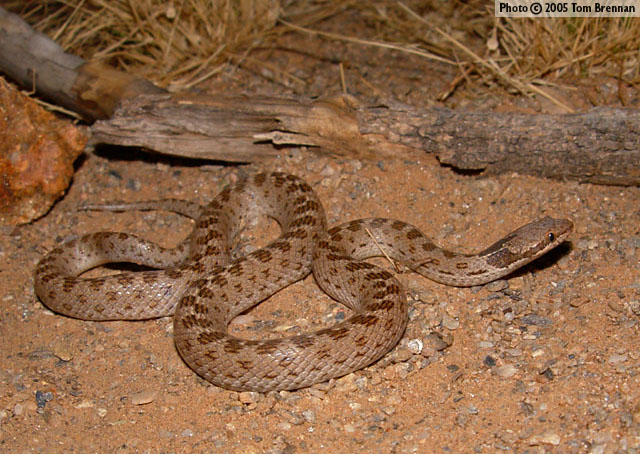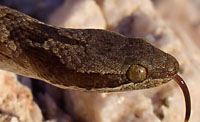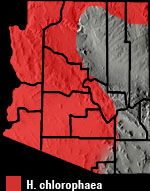Online Field Guide to The Reptiles and Amphibians of Arizona



Pinal County, AZ
 Yuma Co., AZ |
| DESERT NIGHTSNAKE Hypsiglena chlorophaea |
Mildly-Venomous
|
| DESCRIPTION: A small (up to 598 mm or 23″ in total length) gray, or tan snake with small, dark, gray-brown blotches on the back (dorsal blotches). The dorsal blotches are usually in a single row but are sometimes offset at the midline of the back creating two rows of small, alternating blotches. A dark collar, usually consisting three gray-brown blotches marks the neck. In some south-central Arizona specimens the lateral collar-blotches are fused to the dorsal collar-blotch. The central collar-blotch is relatively broad (compared to our other Hypsiglena) with a thin spine extending anteriorly. A dark gray-brown bar extends back from each eye and expands into the lateral collar blotch. The underside is plain pale gray. The head is relatively flat. The pupils are vertically elliptical and the scales are smooth.
DISTRIBUTION: This snake is distributed across most of western and southern Arizona and across the northern borderlands. It is found ar elevations ranging from sea level to about 8,500′. HABITAT: The Desert Nightsnake inhabits a wide variety of biotic communities ranging from hot and dry Lower Colorado River Sonoran Desertscrub, through the grasslands, and woodlands, and into cool Petran Montane Conifer Forest. It is found in an equally wide variety of terrain types ranging from the flat, open, sandy deserts to steep, rocky, wooded slopes. It seems to be most abundant in moderate terrain within desertscrub and grassland communities.BEHAVIOR: This strictly nocturnal snake hibernates during the cold months of late fall and winter. It is often encountered on remote roadways at night. It is mildly venomous but rarely bites when captured and its venom is not considered to be dangerous to humans.DIET: The Desert Nightsnake uses mild venom injected by enlarged teeth in the rear upper jaw to subdue lizards and small snakes. It also eats reptile eggs, frogs, and a variety of insects.REPRODUCTION: Mating takes place in spring and a clutch of up to 9 eggs is laid in spring or summer. By Thomas C. Brennan Bartlett. 2000. Snakes of North America: Western Brennan, T. C., and A. T. Holycross. 2006. A Field Guide to Amphibians and Reptiles in Arizona. Arizona Game and Fish Department. Phoenix, AZ Brennan, T. C., and A. T. Holycross. 2005. A Field Guide to Amphibians and Reptiles of Maricopa County. Arizona Game and Fish Department. Phoenix, AZ Degenhardt, W. G., Painter, C. W., and Price, A. H.. 1996. Amphibians and Reptiles of New Mexico. University of New Mexico Press. Albuquerque. Fowlie. 1965. The Snakes of Arizona. Azul Quinta Press, Fallbrook, California Lowe, Schwalbe, Johnson. 1986. The Venomous Reptiles of Arizona. Nongame Branch Mulcahy, D.G. 2008. Phylogeography and species boundaries of the western North American Nightsnake (Hypsiglena torquata): Revisiting the species concept. Molecular Phylogenetics and Evolution. 46 1095-1115. Stebbins. 1985. Western Reptiles and Amphibians. Houghton Mifflin. New York, |
|
Visit Partners in Amphibian and Reptile Conservation:


HOME
Copyright © 2023, Arizona Game and Fish Department. All rights reserved.
If you make use of the textual contents of this site in reports, publications, etc. please cite and credit the author(s) and photographer(s). All photos on this website are copyrighted. However, those found in the species account section may be used for any noncommercial scientific, educational, or conservation purposes provided that photographs are not altered and continue to bear the copyright symbol and name of the photographer. Please contact the photographer regarding commercial use of copyrighted photographs.










